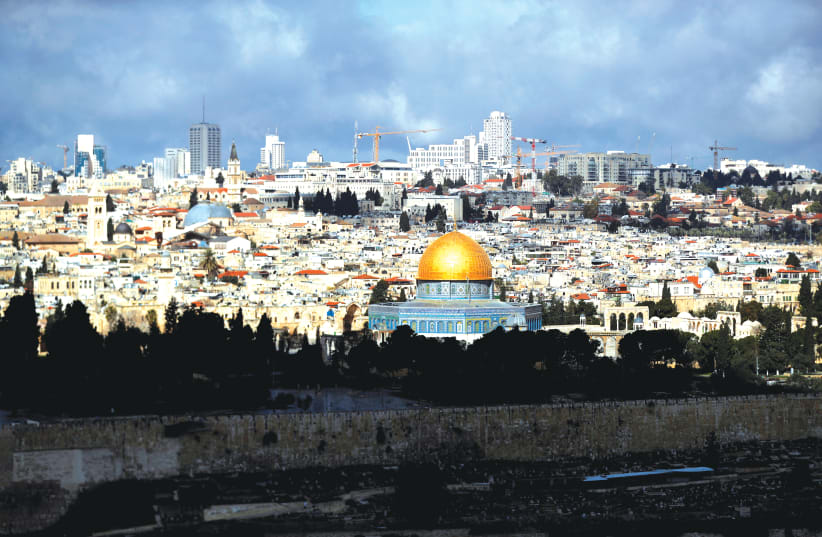Nothing has ever come easily to the Jewish people. For 19 years, from 1948 to 1967, Jerusalem was cut in half, and at the Mandelbaum Gate outside the Old City, there were signs: “Danger. Frontier Ahead. Snipers nearby… stay out of the middle of the street!” The line that severed Jerusalem split neighborhoods and streets down the middle. Jews were evicted from their homes and synagogues in the Old City – and the Western Wall was out of bounds. Across the dividing line, Jordanian troops stood with rifles at the ready.
Jerusalem’s story covers thousands of years, but this segment began in 1948. Before the cease-fire was signed on November 30, Moshe Dayan, the commander of Israel’s forces in Jerusalem, met with his Jordanian counterpart Abdullah e-Tel. In a deserted house in Musrara, they marked out their respective battle lines. They used thick pencils and the jerky lines they drew touched in places. These rough, indistinct lines over time expanded from the heat and blurred, yet they were accepted as the final borders between Jordan and Israel in Jerusalem. The map was locked up at Government House and referred to in all disputes.
On June 5, 1967, while Israel was still warning King Hussein to stay out of the impending war, a foreign radio station announced the conquest of Mt. Scopus by Jordanian troops. It was a mistake, but it confirmed Israel’s suspicions of Jordan’s intention to go to war, and that Mt. Scopus, with its Hebrew University and Hadassah Hospital, was in danger. The Jordanians believed that Israeli troops would come from east to west, but instead the Jerusalem Brigade attacked from the opposite direction, taking Armon Hanatziv, three Jordanian positions, the Arab village of Sur Bahir and Mutzav Hapa’amon. Then several Arab troops came out of hiding and killed six Israeli soldiers.
Below, on the road to Bethlehem, stands Kibbutz Ramat Rahel. Jordanians and Egyptians fought Israelis on the southernmost part of the dividing line and the kibbutz changed hands three times. However, it held fast and eventually contributed to halting the Arab invasion of southern Jerusalem.
Soldiers of the Jordanian legion conquered the High Commissioner’s residence, but were driven back immediately by the IDF which moved toward the City of David. At dawn on Tuesday, the 27th of Iyar, a unit of paratroopers advanced, conquering the Police School, the district of Sheikh Jarrah, the American Colony and the area of the Rockefeller Museum. After a bloody battle at Ammunition Hill, paratroopers reached Mount Scopus.
The 28th of Iyar was Jerusalem’s great day. With a daring thrust, Israeli soldiers scaled the Mount of Olives, advancing beyond the village of Al-Azariya. Armored vehicles burst through the Lions’ Gate toward the Temple Mount. At 10 a.m. came the longed-for announcement: “The Temple Mount is ours. It is in our hands!” Soldiers, even secular ones, ran toward the Western Wall, caressing its stones, their eyes full of tears and with a prayer on their lips, even if they didn’t know the words. Only a few minutes later, Rabbi Shlomo Goren, then IDF chaplain, blew the shofar at the holy site. David Rubinger, a military photographer, took a memorable photo reproduced around the world, of a soldier (now a gynecologist living in Rishon Lezion) named Yitzhak Yifat, removing his helmet and looking up at the Western Wall in awe.
One of the first to reach the wall was a former Australian Mordecai (Mark) Rechtschafner from my hometown of Melbourne. He told me that although he was overwhelmed by the sense of history of that moment, he was far from euphoric. Heavy losses had been sustained and he had lost many comrades.
“I was exhausted, filled with sadness at the unbearable death of so many of my friends. The Six-Day War ended swiftly, but we paid a heavy price.”
Every year, on Jerusalem Day, he comes to Jerusalem from the Kibbutz Ein Zurim, where he lives, to the memorial service, to pay tribute to the many friends he lost in the battle for Jerusalem.
Until the first “intifada” and its ongoing aftermath, the hope of peaceful co-existence between Jews and Arabs seemed a possibility and some believe it still is. Thousands of Arabs poured into western Jerusalem each morning to work at construction sites, factories, hotels and workshops. On week-ends, the narrow lanes of the Old City’s Arab “shuk” (market) would be thronged with Israeli shoppers, but until the pandemic they were mostly tourists who filled its street. Now the future is a question mark as ongoing violence brings renewed tears to families throughout the land that face ongoing terrorist attacks, rockets from Gaza and riots at Damascus Gate.
But the city of Jerusalem remains unforgettable and heartbreakingly beautiful. To me, it is a poem. One night, as darkness descended, I was moved to write these lines.
Black velvet spangled with stars
Is night in Jerusalem.
Splashes of silver,
The sob of the wind,
An ancient perfume,
A taste of nectar.
Skyline of turrets and domes
Is night in Jerusalem.
Pine trees are sighing.
Through a tracery of leaves
Golden lights dot
A midnight canvas.
Landscape of enchantment
Is night in Jerusalem.
The writer is the author of 14 books. Her latest novel is Searching for Sarah.
